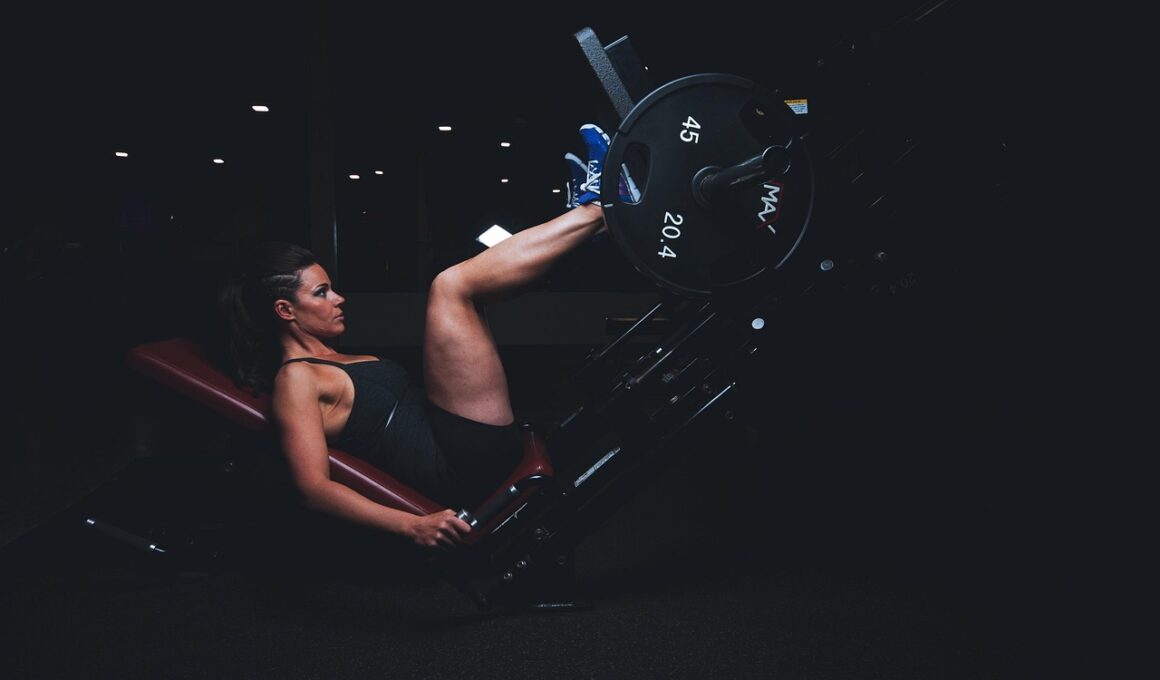Strength Training Mistakes Athletes Should Avoid
Strength training is essential for athletes looking to enhance performance, but several common mistakes can hinder progress. One prevalent error is not having a structured program. Athletes often train without a clear plan, which leads to ineffective workouts. A structured program helps ensure that all muscle groups are targeted appropriately. Additionally, neglecting to prioritize recovery is another significant misstep. Many athletes push through fatigue, failing to allow their bodies to rest. Recovery is crucial for muscle growth and injury prevention. Another mistake is poor exercise form. It’s vital to perform exercises correctly to avoid injuries. Incorrect form not only reduces the effectiveness of the workout but can also lead to long-term damage. Overtraining is another critical issue; athletes must balance between challenging workouts and sufficient recovery periods. Ignoring nutrition is also common; fueling the body with adequate nutrients is essential for optimal performance. Lastly, many athletes fail to set realistic goals. Overly ambitious targets can lead to disappointment and decreased motivation over time. By avoiding these mistakes, athletes can optimize their strength training routines and see better results.
An often overlooked mistake in strength training for athletes is not incorporating sufficient variety into their workouts. Sticking to the same routine can result in plateaus, where improvements in strength cease to occur. To avoid this, athletes should regularly change their exercises, sets, and rep schemes to challenge their bodies in different ways. Variety not only prevents boredom but also stimulates muscle growth and enhances overall performance. Additionally, many athletes underestimate the importance of warm-up routines before lifting weights. A proper warm-up increases blood flow to the muscles and reduces the risk of injury. Skipping this vital step can have negative repercussions during intense training sessions. Moreover, training too heavily without mastering the basic movements can be detrimental; athletes should focus on building foundational strength first. Advanced techniques without a solid base may lead to injuries or ineffective training. Another critical error is neglecting flexibility training. Strong muscles without adequate flexibility can hinder performance and increase injury risks. Incorporating stretching and mobility work into routines is essential for overall athleticism. Lastly, being stubborn about asking for help can be damaging. Athletes should consider seeking advice from coaches.
Common Errors and How to Fix Them
One common error made by athletes in their strength training journey is the tendency to compare themselves to others. While it’s natural to look to fellow athletes for inspiration, constantly measuring performance against others can lead to undue stress and unrealistic expectations. This often results in poor training choices. Athletes should focus on their progress, celebrating small victories. Additionally, neglecting the importance of lifting for endurance is another critical mistake. Many athletes prioritize heavy lifting for power, but improving endurance through lighter weights and higher repetitions is also crucial. This balance contributes to overall fitness and performance consistency across different sports. Another frequent issue is doing exercises that don’t match their sport; athletes need to focus on movements that directly relate to their athletic performance. This specificity improves functional strength. Further, relying too heavily on machines instead of free weights can limit strength gains. Functional training with free weights develops stabilizer muscles crucial in many sports. Finally, underestimating the role of mental training is another mistake. Visualizing success and employing positive self-talk are essential to mental preparedness in competitive environments.
In addition to avoiding previous mistakes, athletes must also be aware of the importance of tracking progress. Many fail to log their lifts and routines properly. Without tracking, it becomes challenging to assess improvements and make necessary adjustments. Keeping a training journal can help athletes identify what works effectively for them. In conjunction with progress tracking, a common misstep is not adjusting the program based on feedback from the body. Listening to one’s body is essential for optimizing training. Athletes should monitor how they respond to workouts and be willing to modify their plans according to their body’s signals. Another prevalent mistake is disregarding the significance of teamwork and camaraderie. Training alone can be demotivating, whereas training with a group can enhance motivation and performance through shared accountability. It’s vital to find supportive training partners or groups. Furthermore, many athletes underestimate the benefits of cross-training. Engaging in different activities provides an excellent balance, working various muscle groups and preventing burnout. Cross-training improves overall athletic ability and helps in injury prevention. Finally, not a single athlete resonates with each trainer; finding the right coach can be a game changer in overall effectiveness.
Conclusion
As we conclude our overview of strength training mistakes athletes should avoid, it’s essential to remember that consistency and awareness are vital. Developing a successful strength training routine requires tailored approaches for individual needs, setting apart successful athletes from the rest. Athletes must educate themselves about the science behind strength training and apply that knowledge practically during workouts. This not only maximizes effectiveness but also ensures safety throughout the process. Moreover, understanding and respecting one’s limits is crucial for sustainable growth. Avoiding injuries through careful training will enhance their long-term athletic journey. Prioritizing self-care and recognizing the value of rest days in the-training regimen cannot be understated. Rest is not a sign of weakness but rather a strategic component in building resilience. As athletes strive for personal bests, they will find that understanding these common pitfalls is first step towards optimization. Continued education within strength training allows athletes to make informed decisions that positively impact their performance. Remember, each journey differs, and tailoring workouts to meet your specific strengths and weaknesses will yield the best results. The path to becoming a well-rounded athlete is ongoing but achievable.
Consulting knowledgeable coaches or trainers is advisable for personalized guidance. Their expertise can significantly enhance training effectiveness. Moreover, athletes should be open to continuous learning through workshops or online courses regarding strength training. The more knowledgeable athletes become, the greater their chances for improvement. In these ways, you set yourself up for success by adhering to the best practices and avoiding common pitfalls inherent in strength training. Revisiting the fundamental principles regularly ensures that athletes maintain their focus on essential techniques. Each decision made in the gym serves as a building block toward overall strength and performance. By avoiding mistakes to create powerful habits, athletes strengthen their foundation, allowing for more advanced techniques to become effective. As you progress, keep reevaluating your goals and training methods. Set achievable outcomes and prioritize enjoyment in the process. With consistent and mindful practice, athletes may achieve their potential in strength training. Thus, they unlock new levels of athletic performance, paving the way for success across competitive landscapes. Truly understanding your body, its needs, and the value of balanced training will set you apart from the pack.
Taking the time to reflect on one’s training approach lays the groundwork for success. Embrace the journey of learning as part of your athletic experience. Observing how various training styles affect strength development will allow for greater adaptability in the future. Overcoming challenges and adjusting strategies contribute to sustained progress, keeping motivation high while pursuing fitness goals. A proactive approach to strength training yields exponentially better results than merely following trends. Athletes must challenge prevailing wisdom and critically evaluate methodologies while remaining open-minded to new practices beneficial to their training. Regular assessment of physical and mental well-being should accompany strength training efforts. This allows for holistic improvement, addressing all facets of fitness. As athletes refine their skills and knowledge, they inspire those around them, helping build a strong community of empowered individuals. Fostering collaboration among peers can elevate the excitement for training. A supportive environment motivates personal best performances in each athlete, which ultimately enhances team achievements. In summary, avoid common mistakes, actively pursue growth opportunities, and remember that consistency is key in strength training for athletic success.
As the athletic landscape continuously evolves, the commitment to ongoing growth must not be overlooked. Engage with fellow athletes, trainers, and scientific resources to remain informed. Understanding the context and application of strength training principles become essential for excellence. Sharing knowledge often leads to invaluable insights that can further enhance training practices. By being proactive, athletes can sidestep common pitfalls and approach strength training with confidence. Keep learning, stay curious, and most importantly, train smart. The skills developed through proper strength training can bring about transformative results, setting athletes apart in their respective sports. This takes dedication, perseverance, and an understanding of one’s capabilities. Collaborating with peers in positive environments increases productivity on training days. With every effort made today, athletes are shaping their potential athletic journey for tomorrow. Reinventing training philosophies becomes possible with each learning experience, as the desire for improvement fuels athletes’ passion. Embrace the process, aim higher, and take pride in the small victories that accumulate over time. This approach ensures a much more fulfilling and successful athletic career as they avoid common mistakes in strength training.


